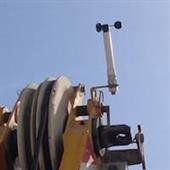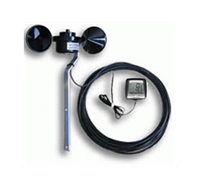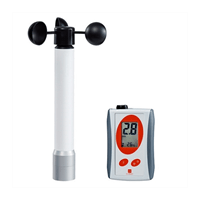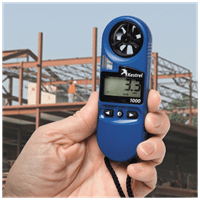Why is wind speed important for Cranes and Hoists?
Why is wind speed important for Cranes and Hoists? |
 | A crane is a machine that is used for raising or lowering a load and also moving it horizontally well
beyond the capabilities of
a human worker. Cranes are equipped with cables and pulleys and operate based upon the application
of fundamental mechanical
principles to move heavy objects. A crane is most commonly used to hoist heavy equipment and
materials on construction sites
and to load cargo to ships. A key component of a crane is the boom.
| |
The boom the long, telescopic or fixed arm that is used to raise and lower objects. The boom
length can vary between different
cranes with the world’s largest tallest and strongest telescopic boom crane reaching lengths of
167m.
Each crane has a load chart that specifies the crane’s capabilities to lift a load. The chart
details its features and how
its lift capacity varies when considering distance and angle. This very important to conceded
while operating a crane to
ensure occupational health and safety guidelines are followed on a work site. Using a crane
beyond its load capacity can
cause the crane to tip over and seriously endanger the safety of worksite personnel.
Wind can have a large impact on a crane’s operation. Winds are able to impose extra loads on a crane’s boom and affect the crane’s stability. Where wind speeds are greater than those recommended by the manufacturer, this may cause the load to move uncontrollably or the crane to exceed known limits. This may cause the crane to topple over and causing a serious accident. The wind speed at the top of a boom-dependent on the boom length and luffing angle may be greater compared to the wind speed the crane’s cabin. It is important to know the wind speed at the tip of the boom to ensure the crane is operating is a safe manner. To measure the wind speed, you can use a cup anemometer. A cup anemometer is a specific type of wind speed gauge that measures the speed of wind based on how quickly a set of cups turns around in a circle. A cup anemometer works when the wind is caught in each cup and pushes the cup to rotate and then the wind catches the next cup in its path, making the cup spin. The number of revolutions per minute will determine how fast or strong the wind is blowing. The advantage of a cup anemometer is the cups will spin regardless which direction the wind is coming from. This is ideal for use on a crane boom as you won’t have to point it towards the direction of the wind to measure the wind speed. The Vortex P-30 is a rugged anemometer with dual digital display handles speeds from 3 mph to over 125 mph. Comes with exterior grade wire. Comes with 30m of cable. The Vortex Pole Mount Anemometer is an inexpensive way to provide you with accurate wind speed in places where AC power may not be available. The Vortex Pole Mount Anemometer display is a high quality, Sigma Sport bicycle computer Battery life is around 1,000 hours of continuous use. The WR-3 is a long range portable wireless anemometer. It has handheld/portable display unit and sensor suitable for both permanent and temporary installation. Sensor with ball bearings and life time battery ensure long period without servicing. Sensor send data every 2 second and you have instant information about wind speed anywhere in the 400m radius from the sensor. Each sensor has his own address so several anemometers can operate in close proximity without disturbance. Another popular option in our range is the Kestrel 1000 which is a vane style anemometer that is drop tested and waterproof.
If you’re still unsure about which anemometer meter is right for you, contact one of our
scientists on 1300 737 871 or at
[email protected] | ||
See our other newsletter articles here!
Contact our expert scientists now to get the right meter or data logger to suit your needs and discuss your project.
Phone: 1300 737 871
Email: [email protected]



